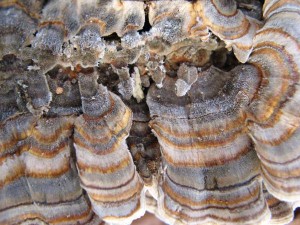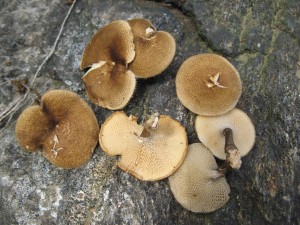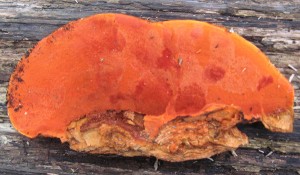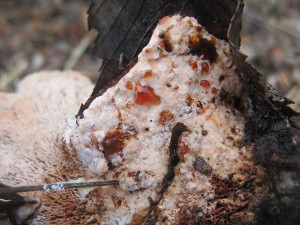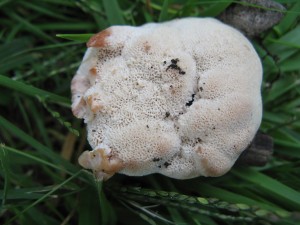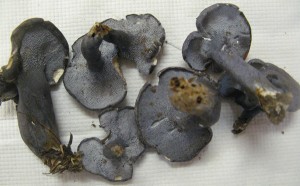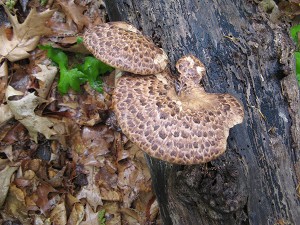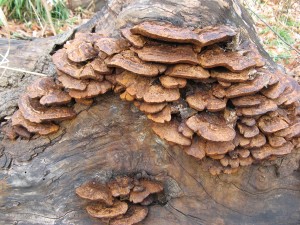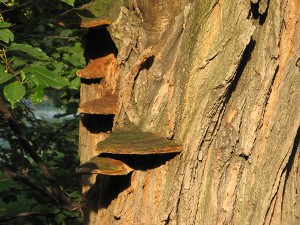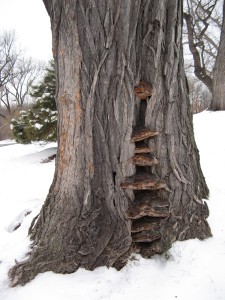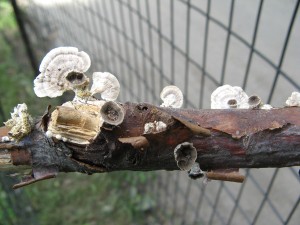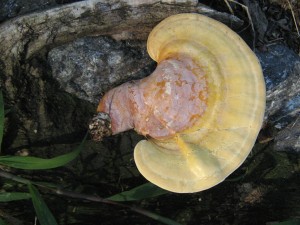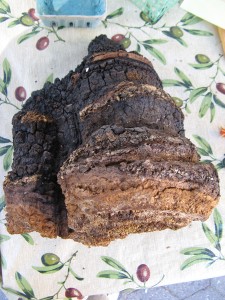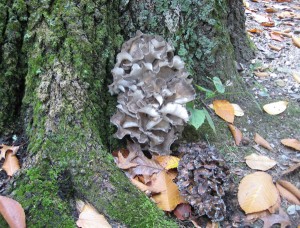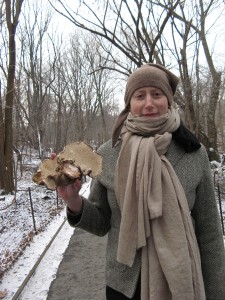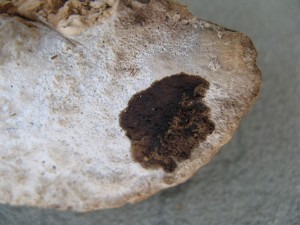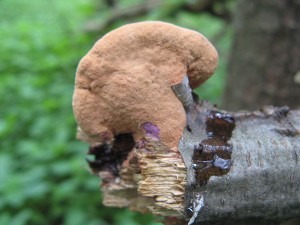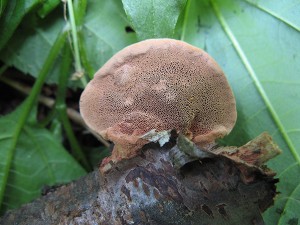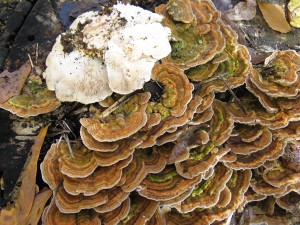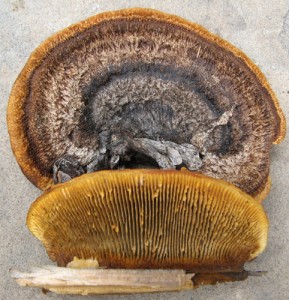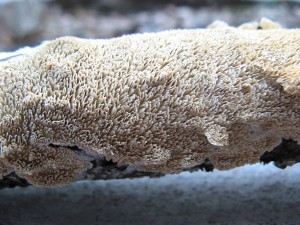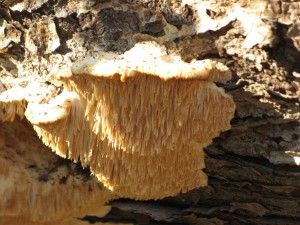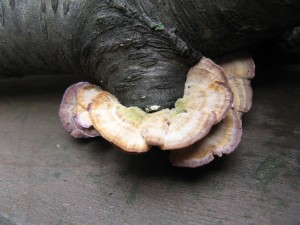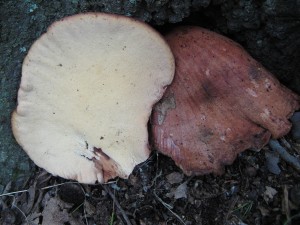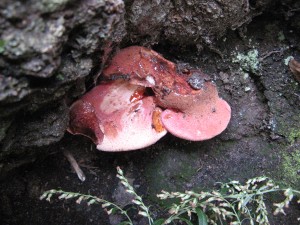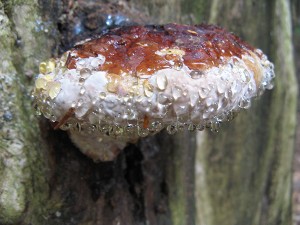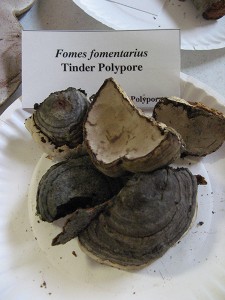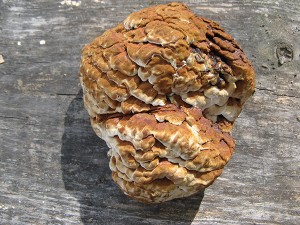Trametes versicolor (Turkey-tail)
Polyporus arcularius (Spring Polypore)
50 POLYPORES to get to know: These are your neighbors most anytime of year……….
We who live in Northeastern North America live surrounded by a rich variety of woodland trees – all our oaks and hickories and birches and beech and maples and pines and hemlocks, etc., etc., and all of these trees either live symbiotically with particular mushrooms or are attacked or decomposed by a large variety of other mushrooms. Polypores are a conspicuous component of our northeast flora – and we find polypores year-round on our mushroom forays. Some occur at particular times while others can be found nearly year-round. Spend time in the Rocky Mountains looking for mushrooms and you’ll discover how few polypores are there. True, there are far fewer kinds of trees in Rocky Mountain forests than here. The same is true of much of California, even with a greater tree diversity: the polypores are conspicuous by their absence! Being blessed as we are with such a treasury of polypores, how many do we actually notice or collect or try to identify – besides those few that we know to be edible? It’s time to learn a little more about our ever-present park and woodland neighbors, the polypores.
Text and photos to follow, as time allows……
REFERENCES:
Gilbertson & Ryvarden. Polypores of North America
Lincoff, G. Audubon Field Guide to North American Mushrooms
Overholts, L. Polyporaceae of the U.S. and Canada
Volk, Tom. – Polypore Primer – See his website……
See the NOTE at the bottom on EDIBLE POLYPORES…….
* = a description, discussion & photo in The Audubon Guide
Abortiporus biennis
*Albatrellus caeruleoporus
Antrodia malicola
*Bjerkandera adusta
*Bondarzewia berkeleyi
*Ceriporia (Poria) spissa
*Coltricia cinnamomea
*Coltricia montagnei
*Daedalea quercina
*Daedaleopsis confragosa
*Favolus alveolaris
*Fistulina hepatica
*Fomes fomentarius
*Fomitopsis pinicola
Fomitopsis spraguei
*Ganoderma applanatum
*Ganoderma curtisii & G. sessile (= G. lucidum)
*Ganoderma tsugae
*Globifomes graveolens
*Gloeophyllum sepiarium
*Gloeoporus (Caloporus) dichrous
*Grifola frondosa
*Hapalopilus nidulans
*Inonotus dryadeus
Inonotus hispidus
*Inonotus obliquus
*Irpex lacteus
*Ischnoderma resinosum
Laetiporus cincinnatus
*Laetiporus sulphureus
*Lenzites (Trametes) betulina
*Meripilus sumstinei (giganteus)
*Oxyporus populinus
Perenniporia……….
*Phaeolus schweinitzii
*Phellinus gilvus
*Phellinus robiniae (rimosus)
*Piptoporus betulinus
*Polyporus arcularius
*Polyporus brumalis
*Polyporus squamosus
*Polyporus varius (elegans) (leptocephalus)
*Postia (Oligoporus) caesia
*Pycnoporus (Trametes) cinnabarinus
*Spongipellis pachyodon
*Trametes (Poronidulus) conchifer
Trametes gibbosa
Trametes hirsuta
*Trametes versicolor
*Trichaptum biforme
*Tyromyces chioneus
Pycnoporus (Trametes) cinnabarinus (Cinnabar Polypore)
——————————————————————–
Abortiporus biennis (showing different forms – and it “bleeding” or oozing red liquid)
—————————————————————————————————-
Albatrellus caeruleoporus (The Blue Polypore)
——————————————————————-
Polyporus squamosus (Dryad’s Saddle)
——————————————————————
Phellinus gilvus
—————————————————————
Phellinus robiniae (rimosus) – the cracked cap polypore
———————————————————————
Trametes (Poronidulus) conchifer (Little Nest Polypore)
————————————————————————-
Ganoderma curtisii (Yellow capped Reishi)
———————————————————————-
Ganoderma tsugae (Hemlock Reishi)
——————————————————–
Inonotus obliquus (Chaga)
———————————————————-
Grifola frondosa (Hen of the Woods)
—————————————————————-
Laetiporus sulphureus (Chicken Mushroom)
————————————————————-
Piptoporus betulinus (Birch Polypore) [being held by Juniper Perlis]
———————————————————————————
Daedalea quercina – a drop of ammonia or KOH on the surface turns it black instantly.
——————————————————————————————————-
Hapalopilus nidulans – a drop of ammonia or KOH on the surface turns it purple instantly.
—————————————————————————————————
Lenzites betulinus (Gilled Polypore on hardwoods)
—————————————————————-
Gloeophyllum sepiarium (Gilled Polypore on conifers)
———————————————————————
Irpex lacteus (Crust-like milk-white “toothed” polypore)
————————————————————————-
Spongipellis pachyodon
————————————————————————–
Trichaptum biforme (Purple-edged tooth-like polypore)
————————————————————————–
Fistulina hepatica (The Beefsteak Polypore)
———————————————————————–
Fomitopsis pinicola (Red-belted Polypore – very young stage, with distinctive dewatering)
————————————————————————
Fomes fomentarius (Tinder Mushroom)
———————————————————————————————————-
Ischnoderma resinosum (Resinous Polypore)
——————————————————————
Globifomes graveolens (Sweet Knot)
——————————————————————————————————-
Fomitopsis officinalis (Agarikon) [From the Pacific Northwest / being held up by Paul Stamets]
12 EDIBLE POLYPORES
Albatrellus ovinus (Sheep Polypore)…..This is one of the most popular edibles in northern Europe.
Bondarzewia berkeleyi (Berkeley’s Polypore)…….When young this is a very good edible, but it becomes bitter and tough as it ages.
Fistulina hepatica (Beefsteak Polypore)……This is a choice edible mushroom, especially RAW…..It has a lemon like flavor and a great texture.
Ganoderma “lucidum” – American Reishi msuhrooms…..We eat this in the early spring when it first appears – very tender and cooks up nicely.
Grifola frondosa (Hen of the Woods)…..One of the most popular edible mushrooms, often gathered in huge quantities in the fall.
Inonotus oblquus (Chaga)…..Consumed as a beverage – and becoming more and more popular.
Ischnoderma resinosum (Resinous Polypore)…..This is being eaten with no apparent problems – but questions persist about consuming it.
Laetiporus cincinnatus (White Chicken Mushroom)…..One of the very best of the edible polypores. Very tender and excellent flavor and texture.
Laetiporus sulphureus (Chicken Mushroom)…..While it can be tough when old, it’s a choice edible when young. Some people are allergic to this mushroom.
Meripilus sumstinei (Black Staining Polypore)…..Only edible when very young, but it has a good texture and flavor then.
Polyporus squamosus (Dryad’s Saddle)…..A very good edible in the early spring – before it matures and becomes too tough to eat.
Trametes versicolor (Turkey-tail)…..Eaten as a food in the Amazon and parts of Asia. Sold in Korean soup packages and sold loose in Chinese markets (for tea).
NOT ALL POLYPORES ARE EDIBLE. One in particular, Hapalopilus nidulans, is poisonous – and has caused organ damage !


